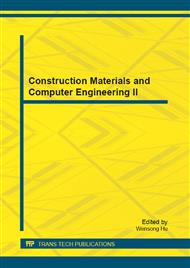[1]
M.Y. Shahin: Pavement Management for Airports, Roads, and Parking Lots, Second Edition (Springer, New York 2005).
Google Scholar
[2]
D.X.M. Zheng, S.T. Ng and M.M. Kumaraswamy: Applying a genetic algorithm-based multiobjective approach for time-cost optimization, Journal of Construction Engineering and Management Vol. 130 (2) (2004), pp.168-176.
DOI: 10.1061/(asce)0733-9364(2004)130:2(168)
Google Scholar
[3]
D.X.M. Zheng and S.T. Ng: Stochastic time-cost optimization model incorporating fuzzy sets theory and nonreplaceable front, Journal of Construction Engineering and Management Vol. 131 (2) (2005), pp.176-186.
DOI: 10.1061/(asce)0733-9364(2005)131:2(176)
Google Scholar
[4]
K. El-Rayes and A. Kandil: Time-cost-quality trade-off analysis for highway construction, Journal of Construction Engineering and Management Vol. 131 (4) (2005), pp.477-486.
DOI: 10.1061/(asce)0733-9364(2005)131:4(477)
Google Scholar
[5]
Y. Xiong and Y.P. Kuang: Time-cost trade-off of construction project based on ant colony algorithm, System Engineering Theory and Practice Vol. 27 (3) (2007), pp.105-111.
Google Scholar
[6]
T.F. Fwa, W.T. Chan and K.Z. Hoque: Analysis of pavement management activities programming by genetic algorithms, Transportation Research Record Vol. 1643 (1998), pp.1-6.
DOI: 10.3141/1643-01
Google Scholar
[7]
N.R. Tayebi, F. Moghadasnejhad and A. Hassani: Analysis of pavement management activities programming by particle swarm optimization, ACEEE Int. J. on Communication Vol. 2 (1) (2011), pp.22-27.
Google Scholar
[8]
P. Chootinan: Pavement maintenance programming using a stochastic simulation-based genetic algorithm approach, Master Thesis, Department of Civil and Environmental Engineering. Utah State University, Logan, UT (1991).
Google Scholar
[9]
P.L. Durango and M. Madanat: Optimal maintenance and repair policies in infrastructure management under uncertain facility deterioration rates: an adaptive control approach, Transportation Research 36A, (2002), pp.763-778.
DOI: 10.1016/s0965-8564(01)00038-6
Google Scholar
[10]
J.H. Chen, M.C. Su and L.R. Yang: Comparison of SOM-based optimization and particle swarm optimization for minimizing the construction time of a secant pile wall, Automation in Construction Vol. 18 (6) (2009), pp.844-848.
DOI: 10.1016/j.autcon.2009.03.008
Google Scholar
[11]
K.W. Chau: Application of a PSO-based neural network in analysis of outcomes of construction claims, Automation in Construction Vol. 16 (5) (2007), pp.642-646.
DOI: 10.1016/j.autcon.2006.11.008
Google Scholar
[12]
Public construction commission annual report on http: /www. pcc. gov. tw/pccap2/TMPLfronted/EngIndex. do?site=004, Public Construction Commission (PCC), Executive Yuan, Taiwan. (2013).
Google Scholar
[13]
J. Kennedy and R.C. Eberhart: Particle swarm optimization, Proceedings of 1995 IEEE Conf. on Neural Networks, IV, Piscataway, NJ (1995), p.1942-(1948).
Google Scholar
[14]
R.C. Eberhart and Y. Shi: Tracking and optimizing dynamic systemwith particle swarms, Proceeding of IEEE Congress on Evolutionary Computation CEC Piscataway, NJ (2001), pp.94-97.
DOI: 10.1109/cec.2001.934376
Google Scholar
[15]
J. Kennedy, R.C. Eberhart and Y. Shi, Swarm Intelligence (Morgan Kaufmann, San Francisco, CA 2001).
Google Scholar
[16]
M. Clerc and J. Kennedy, The particle swarm-explosion, stability, and convergence in a multidimensional complex space, IEEE Transactions in Evolutionary Computation Vol. 6 (1) (2002), pp.58-73.
DOI: 10.1109/4235.985692
Google Scholar


